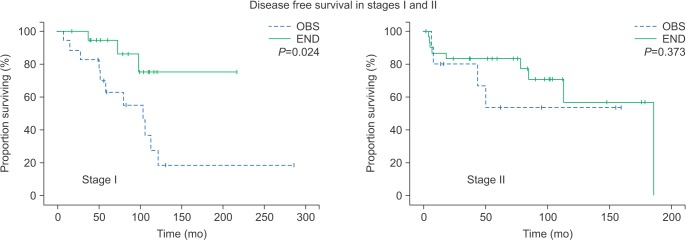J Korean Assoc Oral Maxillofac Surg.
2016 Dec;42(6):358-364. 10.5125/jkaoms.2016.42.6.358.
Elective neck dissection versus observation in early stage oral squamous cell carcinoma: recurrence and survival
- Affiliations
-
- 1Department of Oral and Maxillofacial Surgery, Yonsei University College of Dentistry, Seoul, Korea. cha8764@yuhs.ac
- 2Department of Oral and Maxillofacial Surgery, Ewha Womans University Medical Center, Seoul, Korea.
- 3Oral Cancer Research Institute, Yonsei University College of Dentistry, Seoul, Korea.
- KMID: 2364003
- DOI: http://doi.org/10.5125/jkaoms.2016.42.6.358
Abstract
OBJECTIVES
To evaluate the results of elective neck dissection versus those of observation in the treatment of early stage oral squamous cell carcinoma and to identify factors related to recurrence and survival.
MATERIALS AND METHODS
This was a retrospective study of 52 patients who underwent elective neck dissection and 27 who did not receive neck dissection.
RESULTS
In survival analyses, elective neck dissection showed a benefit in overall recurrence (P=0.027), especially in stage I patients (P=0.024). With regard to survival, the benefit was statistically insignificant (P=0.990). In multivariable analysis, overall recurrence was independently related to poor histologic grade (odds ratio [OR]=9.65, P=0.006), and cancer-specific death was independently related to advanced age (OR=6.3, P=0.022), higher clinical T stage (OR=15.2, P=0.01), and poorly differentiated histologic grade (OR=6.6, P=0.025).
CONCLUSION
Though there was lower recurrence in the elective neck dissection group, there were no statistically significant results on survival. The characteristics of the tumor itself, such as clinical T stage and poor histologic grade, may be more important in cancer-specific survival.
MeSH Terms
Figure
Reference
-
1. Byers RM, El-Naggar AK, Lee YY, Rao B, Fornage B, Terry NH, et al. Can we detect or predict the presence of occult nodal metastases in patients with squamous carcinoma of the oral tongue? Head Neck. 1998; 20:138–144. PMID: 9484945.
Article2. Kurokawa H, Yamashita Y, Takeda S, Zhang M, Fukuyama H, Takahashi T. Risk factors for late cervical lymph node metastases in patients with stage I or II carcinoma of the tongue. Head Neck. 2002; 24:731–736. PMID: 12203797.
Article3. Pimenta Amaral TM, Da Silva Freire AR, Carvalho AL, Pinto CA, Kowalski LP. Predictive factors of occult metastasis and prognosis of clinical stages I and II squamous cell carcinoma of the tongue and floor of the mouth. Oral Oncol. 2004; 40:780–786. PMID: 15288831.
Article4. Werning JW, Heard D, Pagano C, Khuder S. Elective management of the clinically negative neck by otolaryngologists in patients with oral tongue cancer. Arch Otolaryngol Head Neck Surg. 2003; 129:83–88. PMID: 12525200.
Article5. Yuen AP, Ho CM, Chow TL, Tang LC, Cheung WY, Ng RW, et al. Prospective randomized study of selective neck dissection versus observation for N0 neck of early tongue carcinoma. Head Neck. 2009; 31:765–772. PMID: 19408291.
Article6. Fakih AR, Rao RS, Borges AM, Patel AR. Elective versus therapeutic neck dissection in early carcinoma of the oral tongue. Am J Surg. 1989; 158:309–313. PMID: 2802032.
Article7. Vandenbrouck C, Sancho-Garnier H, Chassagne D, Saravane D, Cachin Y, Micheau C. Elective versus therapeutic radical neck dissection in epidermoid carcinoma of the oral cavity: results of a randomized clinical trial. Cancer. 1980; 46:386–390. PMID: 6992980.
Article8. Keski-Säntti H, Atula T, Törnwall J, Koivunen P, Mäkitie A. Elective neck treatment versus observation in patients with T1/T2 N0 squamous cell carcinoma of oral tongue. Oral Oncol. 2006; 42:96–101. PMID: 16256414.
Article9. Liu TR, Chen FJ, Yang AK, Zhang GP, Song M, Liu WW, et al. Elective neck dissection in clinical stage I squamous cell carcinoma of the tongue: does it improve regional control or survival time? Oral Oncol. 2011; 47:136–141. PMID: 21216182.
Article10. Lubek J, El-Hakim M, Salama AR, Liu X, Ord RA. Gingival carcinoma: retrospective analysis of 72 patients and indications for elective neck dissection. Br J Oral Maxillofac Surg. 2011; 49:182–185. PMID: 20462676.
Article11. Feng Z, Li JN, Li CZ, Guo CB. Elective neck dissection versus observation for cN0 neck of squamous cell carcinoma primarily located in the maxillary gingiva and alveolar ridge: a retrospective study of 129 cases. Oral Surg Oral Med Oral Pathol Oral Radiol. 2013; 116:556–561. PMID: 24119520.
Article12. Argiris A, Karamouzis MV, Raben D, Ferris RL. Head and neck cancer. Lancet. 2008; 371:1695–1709. PMID: 18486742.
Article13. Kowalski LP, Sanabria A. Elective neck dissection in oral carcinoma: a critical review of the evidence. Acta Otorhinolaryngol Ital. 2007; 27:113–117. PMID: 17883186.14. Fasunla AJ, Greene BH, Timmesfeld N, Wiegand S, Werner JA, Sesterhenn AM. A meta-analysis of the randomized controlled trials on elective neck dissection versus therapeutic neck dissection in oral cavity cancers with clinically node-negative neck. Oral Oncol. 2011; 47:320–324. PMID: 21459661.
Article15. Eicher SA, Overholt SM, el-Naggar AK, Byers RM, Weber RS. Lower gingival carcinoma. Clinical and pathologic determinants of regional metastases. Arch Otolaryngol Head Neck Surg. 1996; 122:634–638. PMID: 8639295.
Article
- Full Text Links
- Actions
-
Cited
- CITED
-
- Close
- Share
- Similar articles
-
- The effectiveness of elective neck dissection on early (stage I, II) squamous cell carcinoma of the oral tongue
- Elective Neck Dissection in Oral Squamous Cell Carcinoma
- Is elective neck dissection needed in squamous cell carcinoma of maxilla?
- Neck dissection of clinically N0 Neck of oral squamous cell carcinoma & pathologic comparison
- Importance of elective neck dissection in cN0 maxillary squamous cell carcinoma





